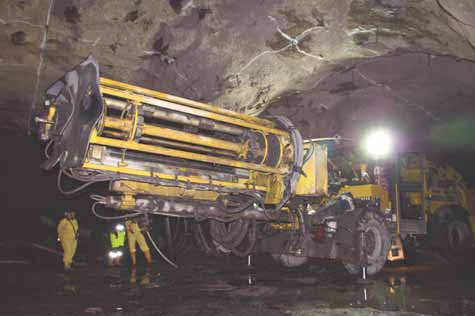
This Cabletec LC cable bolting rig is part of the blast hole drilling and support placement
equipment fleet at Zinkgruvan.
A New Era of Nordic Mining
Invigorating the old, advancing the new, resurrecting the moribund
By Kyran Casteel, European Editor

Thanks to changes in legislation and regulation introduced in the 1990s, and boom conditions in the world minerals and metals markets, a number of substantial new operations are at an advanced stage of development by foreign- based companies, one former Outokumpu operation has been reopened this year and the company’s Hitura mine has been sold. There are also plans to re-open the Dannemora iron ore mine in central Sweden and the Black Angel base metals mine in Greenland. Equally significant for the industry are the major expansions planned for Boliden’s Aitik copper mine and the continuing optimization of production at LKAB’s iron ore operations and Outokumpu’s Kemi chromite mine. Meanwhile government, the industry and academia are working to make education and R&D more effective, as E&MJ will report in a later issue.
Zinkgruvan—150 and Still Growing
Historically, 2006 was the best year
ever at Zinkgruvan Mining AB (ZMAB),
in terms of both production and financial
performance. Not bad for a mine
that marked 150 years of continuous
operation in September 2007 with a
celebration at nearby Ammeberg, the
town which gave its name to the original
operating company and was the site
of the previous process plant replaced
in 1977. Not bad either for owner
Lundin Mining, created only three years
previously after South Atlantic Ventures
bought Zinkgruvan from Rio Tinto and
changed its name to Lundin Mining
Corp. Production in 2006 totalled
787,889 mt ore with zinc head grade
10.3%, lead 4.6%; recovery rates were
93.8% for zinc and 88.5% for lead,
yielding concentrates that graded 54%
zinc and 75% lead and contained
75,909 mt zinc, 31,850 mt lead and
1.76 million oz silver. And ZMAB
expects to produce 850,000 mt ore in
2007.
While the record financial performance has been helped by high metal prices, the production achievements reflect first the fact that Lundin has put a great deal of effort into Zinkgruvan since buying it, and second that this work built on substantial investments by previous owners, especially from 1990 onward. In the early 1990s, the original Belgian owner Vieille Montagne (by then part of Union Minière) introduced new technology and management practices that cut mining and processing costs by about 50%, converting a high-cost operation to the sixth lowest cost producer in the world. Technical innovations included remote controlled loading and the use of electric trucks to “hoist” ore from new mining levels to the main haulage and underground crusher level.
After North Ltd. bought Ammeberg Mining in 1996 (changing its name to Zinkgruvan Mining AB in 1997), the Australian company spent a lot of money on exploration and discovered a copper occurrence comprising disseminated and stockwork chalcopyrite hosted in dolomitic marble on the hanging wall of one of the main zinc orebodies, Burkland. It also invested in upgrading the process plant, particularly the flotation equipment, achieving significantly better performance and brought in Jama mechanized scaling rigs.
Rio Tinto acquired North in 2000 primarily for the company’s large iron ore holdings, prompting the financial community to anticipate the rapid sale of a mine which produced zinc ore—not a core Rio product—in quantities that were relatively small in the company’s scale of things. In fact the big Brit also made significant changes in practice and related investments before selling the operation in 2004. These included the introduction of a new mine layout with panel mining, the first application of paste backfill in Sweden, new production drilling technology and a five-year equipment purchase plan as well as continued exploration. Although Rio introduced new safety practices aimed at maintaining the downward trend in accident rates achieved through the 1990s, these have actually moved up and down so far this century, a situation that Lundin is presently trying to address. And the Rio Tinto board did not make a decision on plans to extract 300,000–500,000 mt of copper ore from 2005-6.
Plans for a Long-Term Future
Anxious to optimize the newly acquired
major asset, Lundin Mining has also continued
intensive near-mine exploration
and pursued a program of various
upgrades. In 2006, the company added a
new drill core archive building, overhauled
the ventilation system to reduce
energy consumption and completed
reclamation of previously worked land. In
the last quarter of 2006, ZMAB decided
to bring in contractors in a bid to speed
the development rate and also to carry
out the narrow vein mining required in
some parts of the mine. This year ZMAB
is reconstructing the surface crusher for
SEK38 million (€4.1 million) and
upgrading the control technology for the
grinding mills to achieve higher throughput
with substantially reduced noise. The
process team is also taking further steps
to reduce the perennially problematic silica
contents of the concentrates which
incur penalties by smelters, and extending
the tailings dam.
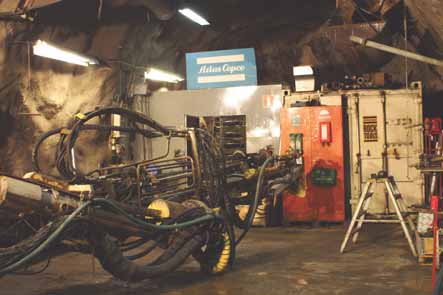
Another key initiative taken in 2006 was development of a new life-of-mine business plan, which is being completed this year. The aim is to increase the life of the mine and its total asset value. The plan is based on the Inco MINE 2-4D system for mine design and scheduling, which works with Zinkgruvan’s MicroStation software. The basis of the plan is increased near-mine exploration to secure an output of at least 800,000 mt/y ore from 2008 to 2019 and then reduce the rate to under 200,000 mt/y in 2024. Studies are in progress as to how to increase production levels while maintaining low cash costs by improving the mine infrastructure. ZMAB has been studying options for mining and processing the copper ore occurrence in order to determine the potential for copper production.
Near-mine exploration has succeeded in discovering a deep northwestern extension of the ore mineralization, with high zinc and lead grades intersected. Further drilling is underway to delineate the discovery, while Lundin is also exploring in the wider Bergslagen region north of the mine. At the end of 2006 reserves and resources included: Proven zinc reserves of 6,635,000 mt at 10% Zn, 5.5% Pb, 113 g/mt Ag; Probable zinc reserves of 2 million mt at 8.9% Zn, 2.7% Pb and 59g/mt Ag; Measured and Indicated zinc resources of 1.8 million mt at 8.3% Zn, 2.6% Pb, 67 g/mt Ag; and Inferred zinc resources of 7.8 million mt at 10.6% Zn, 4.4% Pb, 101 g/mt Ag. Indicated copper resources are 2.8 million mt at 2.9% Cu with some zinc and silver; and Inferred copper resources stand at 890,000 mt at 3.1% Cu with some zinc and silver.
Lundin Meets Copper on the Zinc Trail
As reported last year, Zinkgruvan was
just the start for Lundin Mining. Three
years later the Canadian-Swedish firm
is well on the way to achieving its stated
objective of building the next major
base metals mining house.
Although Lundin’s second Swedish acquisition, the very profitable Storliden zinc-copper operation, will be mined out by the end of this year, having yielded approximately 1.7 million mt ore, the NAN team and Lundin Mining Exploration have interesting prospects. At Norrliden, near Norsjö, the 90:10 partnership with International Gold Exploration has started the permitting process for a mill-less operation like Storliden. At Arvidsjaur, the Eva deposit will also be the subject of a mining license application. Lundin also has an option-to-purchase agreement with Blackstone Venture Corp. covering the Lappvattnet nickel project in Västerbotten and is itself exploring in the Bergslagen region north of Zinkgruvan.
During 2007, Lundin pressed on and diversified further, adding to the copper production at Neves Corvo by agreeing to acquire Rio Narcea Gold Mines, which operates the Aguablanca nickel-copper mine in southern Spain, and Tenke Mining, owner of a 24.75% stake in the massive Tenke Fungurume copper project in the Democratic Republic of Congo, due on-stream in 2008. Tenke Mining was established by the Lundin Group prior to the creation of Lundin Mining Corp.
In addition to the Ozernoe joint venture with Metropol in Buryatia, the company also has strategic investments in a number of exploration companies working in Africa (Sanu Resources, Sunridge Gold), Canada (Mantle Resources) and an interest in what is believed to be the world’s largest known zinc deposit, Mehdiabad in Iran, where its partner is Union Resources.
Nickel to the Fore
To some extent, the spotlight on new
Nordic mining venturers has switched
from Sweden to Finland. This is in no
small part due to Outokumpu’s sales of
precious and base metal assets in
recent years. Nickel is presently a hot
target with precious metals and iron ore
projects also making progress.
One project that has generated a good deal of excitement is Talvivaara, located in Sotkamo. Talvivaara Mining Co. Ltd. (TMCL) and its subsidiary Talvivaara Project Ltd. were incorporated in September 2003 for the purpose of acquiring from Outokumpu (for €1) the two polymetallic deposits, Kuusilampi and Kolmisoppi, at Talvivaara and developing them as a major nickel mine. Although the deposits enjoy a very advantageous stripping ratio for open-pit mining, the nickel grade is low and, in parallel with the company’s exploration of the deposits prior to the decision to exit mining, Outokumpu’s Research Center had developed appropriate low cost bio-heapleaching technology for treating the ore. In February 2004 the new group, led by Pekka Perä, previously the project manager of mining at Arctic Platinum Partnership from 2001 to 2003 and project manager at Pyhäsalmi Mine Oy, acquired the rights to mine the Talvivaara deposits and the rights to use the related geological and bioheapleaching research data. Pera is now CEO of TMCL.
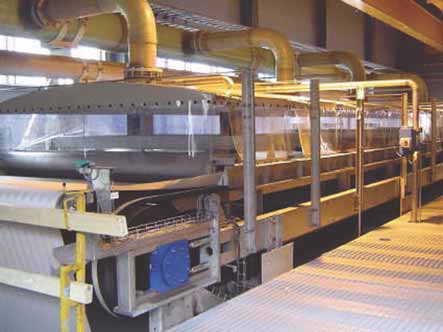
In March 2007, the board of Talvivaara Project approved a bankable feasibility study, containing detailed estimates of all material capital and operating expenditures expected to be incurred in connection with constructing and operating the project; obtained an environmental permit and also obtained other material permits required for the commencement of mining operations. The Talvivaara deposits comprise one of the largest known sulphide nickel resources in Europe with 266 million mt of ore in measured and indicated resources, sufficient to support anticipated production for a minimum of 24 years. Production is expected to start in late 2008, with an expected annual nickel output of approximately 33,000 mt, and TMCL has the potential to provide approximately 2.3% of the world’s current annual production of nickel by 2010. In addition to nickel, as by-products of the process, the mine is also expected to produce zinc (approximately 60,000 mt/y), copper (approximately 10,000 mt/y) and cobalt (approximately 1,200 mt/y).
Next, TMCL made an IPO in London and the company’s shares were listed on the London Stock Exchange on May 30, 2007. The IPO, together with a previously arranged project financing facility, will secure financing for the Talvivaara project and enable its development into an operating mine. Commenting on the company’s proposed listing on the London Stock Exchange, Pera said that it signaled the company’s ambition to become a major producer in the global nickel market through the application of bioheap leaching technology. As a result of the original deal with TMCL, Outokumpu gained a stake in TMCL but, while the stainless steel producer said it supports and endorses the pro- ject for strategic reasons, the holding is classified as an available-for-sale financial asset with changes in fair value recognized directly in equity.
Metso has an interest in the group as a result of collaboration on process development and Norilsk Nickel gained a holding as a result of having purchased OMG’s Harjavalta nickel refinery in March 2007. Antti Aaltonen, a member of the board and president of Norilsk Nickel Finland, and previously president of OMG Finland and OMG Harjavalta Nickel, is a non-executive director of TMCL. Talvivaara has a 10- year off-take agreement for 100% of its nickel and cobalt output with Norilsk Nickel.
The Group has obtained an environmental permit for commencement of mining operations and other material permits required for the commencement of mining operations. Further work on the project will involve the development of the Talvivaara open-pit mines, the construction of processing and ancillary infrastructure and the design, construction and commissioning of a processing facility. The contractors Destia and Karjalan Louhinta ja Lujitustyö (KLL) are doing development drilling at the mine site but Talvivaara project Ltd. will do the production drilling and is about to select equipment at the time of writing.
The process flow in Talvivaara will consist of four main steps: mining, crushing, bio-heap-leaching and metals recovery. Open-pit mining is planned to be at a scale of approximately 15 million mt/y, making it the largest open-pit mine in Finland. Crushing is to be done in three stages, followed by agglomeration with sulphuric acid to consolidate the fines with coarse ore particles. After agglomeration, ore will be conveyed and stacked 8 m high on the primary heap pad for one and one-half years of leaching. After 18 months of leaching on the primary pad, the leached ore will be reclaimed, conveyed and re-stacked onto the secondary heap pad, where it will be leached further to recover metals from those parts of the primary heaps, where leach solution has had poor contact. Such areas include, for example, the slopes and possible precipitates formed inside the heap. After secondary leaching, the barren ore will remain permanently on the secondary heaps. In metals recovery, nickel, copper, zinc and cobalt are precipitated from the pregnant leach solution and filtered to produce saleable metal products. After the metals are removed, the solution is further purified and returned to irrigate the heaps.
Two of Finland’s mineral processing technology suppliers have announced contracts secured from Talvivaara. On July 12, 2007, Larox said it had agreed what is the biggest single contract in the company’s history at €10 million and on August 21, Outotec announced it will supply metals recovery technology valued at approximately €40 million. The Larox contribution will include several Pannevis Horizontal Vacuum Belt Filters (see p.80) with auxiliaries. Delivery will be in two phases during 2008 and 2009.
Outotec’s scope of delivery covers metals recovery technology, including reactors and thickener technology, in which nickel, copper, zinc and cobalt are precipitated from the pregnant leach solution to produce saleable metal products. Technologies will be commissioned in two phases; the first phase is expected to be commissioned in October 2008 and the second phase in autumn 2009. “The Talvivaara nickel project is an important step in the history of bioleaching. Talvivaara’s bioheap leaching technology has its origins at Outotec’s Pori research center in Finland and now this technology will be in commercial use and allow economical beneficiation of the low-grade nickel deposits,” said Outotec’s CEO Tapani Järvinen.
Meanwhile, the sale of the Hitura nickel mine in Finland to Belvedere Resources Ltd. of Canada, agreed in February 2007, was completed in June for a total consideration of €25 million in Belvedere shares and warrants entitling Outokumpu to subscribe for additional Belvedere shares, resulting in a maximum 19.2% ownership in Belvedere, on a fully diluted basis. Outokumpu recognized a nonrecurring gain of €25 million on the transaction. Hitura, the last remaining asset in Outokumpu’s Exit Mining program, produces some 200 mt of nickel in concentrate annually and employs 90 people.
Another large Finnish nickel project, albeit somewhat less advanced at this time, is Scandinavian Minerals’ Kevitsa, located 35 km north of Sodankyla and 142 km north northeast of Rovaniemi which lies on the Arctic Circle. The nickel-copper deposit was discovered in 1984 and subsequently explored by the Finnish Geological Survey (GTK). It was also evaluated by Outokumpu who expanded the resource to 234 million mt but could not find a way to produce the grade of concentrate required for the company’s Harjavalta smelter.
The claims lapsed during the 1990s and were taken up in January 2000 by Scandinavian Gold president and CEO Peter Walker. Scandinavian also acquired the GTK database and hired SRK to carry out a pre-feasibility study. A combination of the unproven process route and low nickel prices kept the project on the backburner until Scandinavian Gold held an IPO in March 2004, the funds from which enabled the company to study alternative metallurgical options at GTK’s mineral processing laboratory in Outokumpu. GTK came up with the idea of using Dow Chemical’s DETA reagent to depress pyrrhotite.
In 2006, having just changed its name, Scandinavian Minerals engaged St. Barbara Consultancy Services and CSA Consultancy to prepare an NI 43- 101 compliant report that St. Barbara then upgraded to a positive pre-feasibility study in July 2006. Scandinavian also produced a bulk sample for pilot plant testing at the GTK laboratory, which GTK MinProc completed processing in February 2007, and in July, the company announced that the testwork had shown that good quality, smeltergrade concentrates can be produced at commercially acceptable levels of recovery by conventional floatation methods. The attaining of very low levels of magnesia in the nickel concentrate and the elimination of TETA from the flotation process were additional achievements.
In April 2007, Scandinavian commissioned a Bankable Feasibility Study, to be coordinated by St. Barbara LLP (formerly St. Barbara Consultancy Services). The London firm is also responsible for ensuring that the study complies with Canadian NI 43-101. The exercise is expected to take approximately 12 months to complete, with technical work, including geology, mining, metallurgy and environmental studies, being performed by leading Finnish engineering and technical consultants.
Following discussions with Outotec, Scandinavian signed with the technology company in June 2007 to carry out detailed engineering work for the Feasibility Study, including open-pit modelling and the design of the planned processing plant for the Kevitsa project. In May and June, the company also finalized its preparation of the Environmental Permit Application for Kevitsa.
Betting on the Pajala Shear Zone
Another longer term project north of the
Arctic Circle and with ferrous intent is
being progressed by Vancouver-based
Northland Resources. The company has
defined three projects within the Pajala
Shear Zone that extends from around
Pajala in Sweden across the Tornio
River into Finland in the Kolari district.
Although iron ore has been mined in
the license area and there is a railhead
at the former Rautavaara mine, this is
one of Europe’s last under-explored iron
ore provinces according to Northland:
the firm hopes to identify in excess of
500 million mt of magnetite resources
and become a significant European iron
ore producer.
So far, Northland has completed NI 43-101 resource calculations for the Stora Sahavaara project on the Swedish side (May 2006) and the five iron, copper- gold occurrences at the Hannukainen project on the Finnish side (August 2007). The calculation for Tapuli, which is close to Stora Sahavaara, should be finished later this year. The Stora assessment defined 121 million mt of measured and indicated resources, plus additional inferred resources, at grades of 43% iron and higher, with 0.07%–0.08% copper. Following initial lab testing that indicated sufficient concentration is feasible the company garnered a 2,000 mt bulk sample which is being piloted in Canada, with results expected in late 2007. Northland thinks that Stora can potentially yield 5 to 7 million mt/y of blast furnace and direct reduction pellets or pellet plant feed over a 20-year mine life.
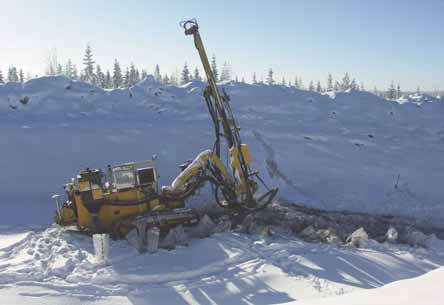
Northland President Buck Morrow said: “We have now begun the technical and permitting work necessary to partially drain the Laurinoja open-pit to expose the pre-stripped magnetite mineralization. This will allow our contractors to begin mining a substantial bulk sample of copper-gold bearing magnetite for pilot-scale metallurgical test work. Bench scale testing has already produced results indicating the potential for production of a high quality, low sulphur magnetite concentrate in addition to a copper-gold concentrate.”
Meanwhile, drilling continues at Hannukainen and the company recently awarded Suomen Malmi Oy (Smoy) a €545,000 drilling contract. Smoy was acquired by the Swedish drilling and raise boring contractor Drillcon AB in mid-2006, doubling the Nora based company’s turnover and making it the largest contractor in Europe specializing in drilling for the mining and construction industries. Listed on the Nordic alternative market First North, Drillcon has 120 employees and is expected to achieve sales of €28 million in 2007.
Results of the various metallurgical testing programs will form the basis for further mine planning and detailed engineering, Northland said. The Canadian company believes the time is ripe for a new European source of iron ore. “Our three mines, estimated to produce 12 to 13 million metric tons yearly, will provide a competitive alternative to imports from other continents,” Morrow said.
Gold Still Glitters
Two companies have made good
progress with gold projects, Canada’s
Agnico-Eagle and the Swedish firm
Lappland Goldminers. With strong earnings
resulting from the sale of its stake
in Contact Diamonds and particularly
strong zinc and silver prices, the
Canadian firm has been piling up cash
and is well financed to develop not only
its three domestic gold projects, Lapa,
Goldex and LaRonde II (E&MJ, March
2007, pp. 44–47), but also the Kittila
project, like Kevitsa north of Rovaniemi
in Finland but in this case west of Sodankyla. Development is on schedule
to possibly add almost 500,000 ounces
to Agnico-Eagle's book in 2008.
Lappland Goldminers, with a staff of
just 14, has had a very busy time
recently as it gears up to bring
Fäboliden onstream. The project is
located 40 km west of Lycksele in
Västerbotten, Sweden, on the so-called
Gold Line.
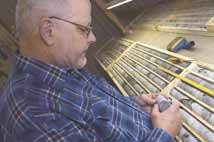
The Fäboliden project has been drilled in stages since 1993 and by second half 2007 some 256 holes totaling almost 47,000 m had been completed, distributed between the the intended open pit and underground mine sites, northern and southern Fäboliden, and grade verification. In December 2005, Outotec (at that time Outokumpu Technology) presented a pre-feasibility study for the mining and processing of 5 million mt/y, with the process plant being able to treat ores from nearby mines as well. In the following year Lappland carried out work needed to prepare an ore reserve statement to SveMin’s standard (generally similar to NI 43-101). Calculated by GeoVista AB, this was completed in February 2007 and gave a proven gold ore reserve of 20.74 million mt at an average 1.43 g/mt, equivalent to 0.95 million oz of which 86% should be recoverable. However, Lappland commented, test mining produced higher grades than those indicated by diamond drilling, a difference confirmed by a verification exercise undertaken by SRK Consulting.
In mid-year, Lappland Goldminers discovered interesting zinc-lead-silvergold mineralization at Gubbträsk and acquired Northern Lion Gold Corp.’s prospects in Finland. In early September, the company hired a project manager and a chief geologist for Fäboliden, both with excellent experience. And on September 18, the firm, which is already listed on First North and the OTC list in Oslo, announced it would apply for full listing on the Oslo Stock Exchange.
Meanwhile, Outotec has been working on the full feasibility study, during which it was decided to add another mill to raise recovery to about 90%. Lappland was able to source a suitable mill from the closed Boliden Laisvall lead mine, also in northern Sweden. Having inspected this mill and pronounced it fit for purpose, Industriteknik was given the task of preparing it for operation. Completion of the study is due at the time of writing and the Environmental Court is expected to rule on the permit application during October. A favorable decision should enable Lappland Goldminers to start gold production during 2009 said CEO Karl-Åke Johansson.
New Life Congregation
The opportunity to generate cash flow
from the current boom has encouraged
a number of companies to evaluate the
possibility of re-opening or revamping
mines previously closed or regarded as
marginal.
In Finland, Dragon Mining has breathed life into assets bought from Outukumpu. The Australia-based firm recently announced the successful restart of the Vammala Production Center and the production of gold concentrate in Finland. In achieving the recommissioning of the Vammala Production Center with production from the Orivesi gold mine, Dragon said, the company is well positioned to achieve targeted gold production in 2007 of 75,000 oz from its two gold mines, the other being Svartliden in Sweden, very close to Fäboliden.
The company said that re-commissioning of the Vammala Production Center culminates the dedicated efforts of the Finnish team lead by Heimo Poyry in reopening the Orivesi mine following the commitment of resources to decline development at the Sarvisuo lodes. These are a series of parallel vertical pipes some 300 m from the previously mined Kutema lodes. Ore haulage from the Orivesi mine, 80 km from the Vammala Production Centre, commenced on June 18 initially hauling stockpiled ore from both previous mining operations and the Kutema pillars. The Vammala plant, which will be operated on a 24-hour basis five days per week, has achieved consistent throughput of 40 mt/hour.
Current reserves and resources stand at 93,000 oz and 216,000 oz, respectively. However extensive drilling undertaken in the past 12 months has provided encouraging additional resources within the hydrothermally altered zone at Orivesi. Results have been regularly released to the market and a new resource statement is being finalized. The company has two underground rigs committed for the remainder of the year. While the majority of the meters to be drilled will be to confirm and upgrade resources, exploration holes are also planned in the program.
In Sweden, Dannemora Mineral AB has been established with the aim of reopening the Dannemora iron ore mine that was closed in 1992. Preliminary plans cited production of 1.5 million mt/y from remaining iron ore reserves put at 24 million mt. The company started trading on First North in May this year. And LKAB has been reported to be considering re-opening the flooded mine at Svappavaara. In Greenland, U.K.-based Angus & Ross is working hard to have the Black Angel zinc-lead mine flying again, thanks to the discovery of new ore in an area recently revealed by the melting of ice cover.